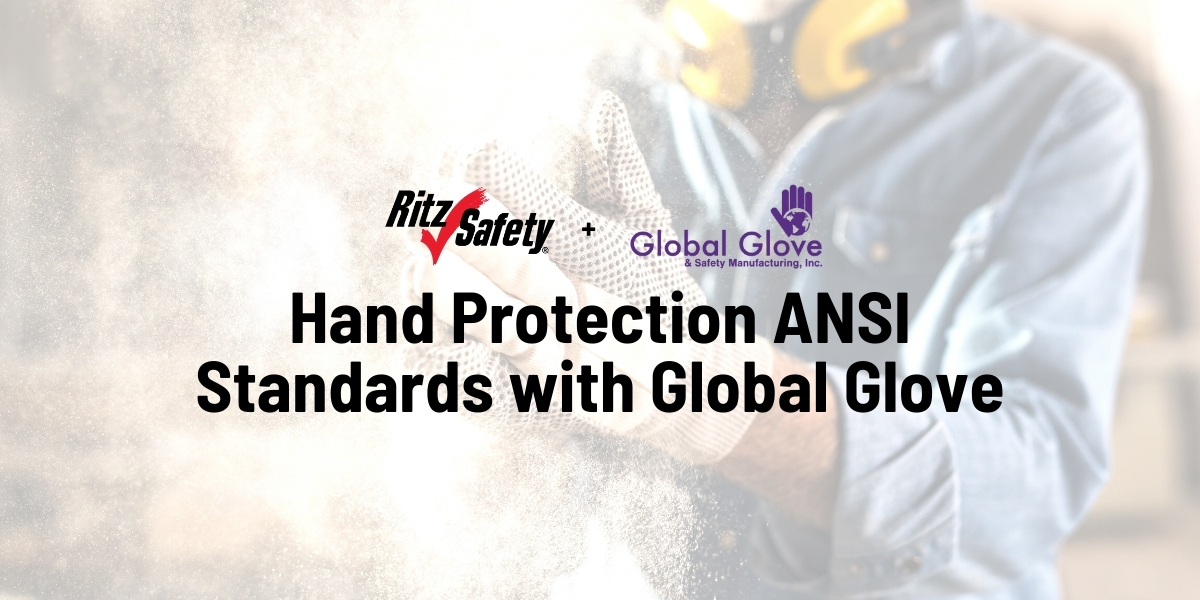
Hand Protection ANSI Standards with Global Glove
When talking about hand protection, quality is paramount. With injuries to the hands and arms taking up 21% of all injuries that require days away from work in 2020, it goes to show why we need durable, quality hand protection. To ensure consistent quality across all of their hand protection, Global Glove puts their gloves through testing to determine their ANSI rated cut, puncture, and abrasion levels. These levels help you choose which glove will be best suited for your needs. Read more about the ANSI testing processes and ANSI cut, puncture, and abrasion levels below.
ANSI Cut Levels
Standards for Cut Testing
The ANSI and ISEA standard for displaying the rating of cut-resistant hand protection is ASTM F2992-15. This standard is used to obtain gram results which is then interpreted into a classification level by the ANSI-ISEA 105-2023 standard. Together, these two standards streamline the cut testing process, ensuring consistency across hand protection.
|
ANSI/ISEA 105-2023 New Icon Designation |
ASTM F2992-15 Standard:
|
Cut Levels
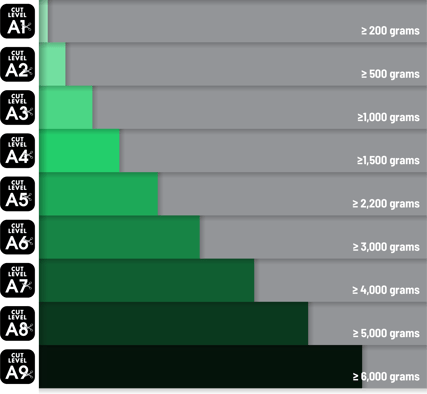
| Cut Level | Application Examples |
| Level A1 | Assembly, Warehouse, Material Handling |
| Level A2 | Automotive, Packaging, Metal Handling |
| Level A3 | Construction, Automotive Assembly |
| Level A4 | Glass Handling, HVAC, Machining, Metal Fabrication |
| Level A5 | Appliance Manufacturing, Glass Handling, HVAC |
| Level A6 | Metal Stamping and Fabrication, Electrical, Construction |
| Level A7 | Aerospace, Window Manufacturing, Recycling |
| Level A8 | Very high cut risks, Aerospace, Recycling |
| Level A9 | Highest cut risks |
Timeline of Cut Resistant Standards
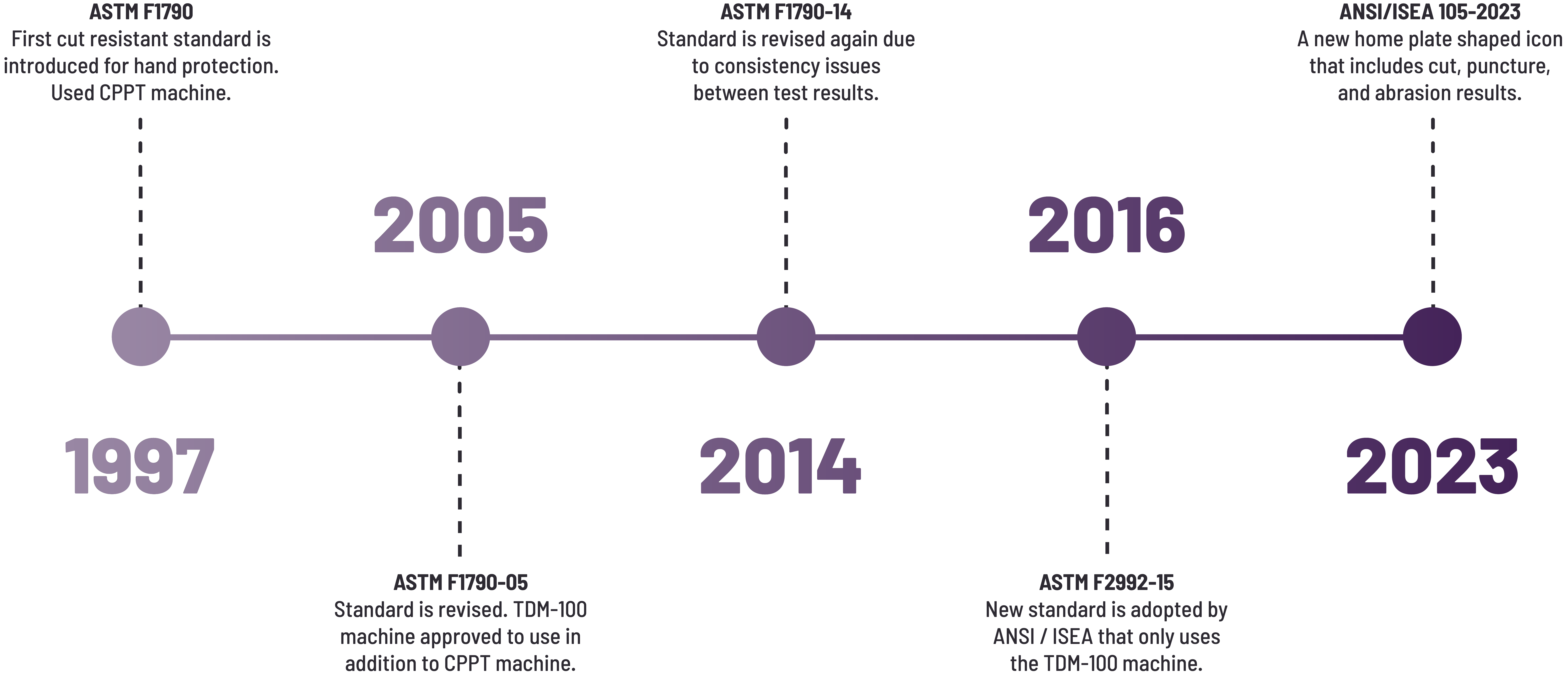
TDM-100 Machine Cut Test
1. Material from the glove, sleeve, or product to be tested is fitted onto the base of the TDM-100 testing machine.
2. A specific weight is applied to a new razor blade, which is then lowered to the material. A motor draws the blade with that applied weight across the material until a cut through occurs. The number of mm to cut-through is reported for that weight.
3. The weight loads are repeated 5 times to provide 15 data-points for cut-through at short, medium, and long blade travel.
4. A linear regression of all 15 data-points provides the calculated weight in grams where the 20 mm blade travel would occur. Three samples are tested for each material for a total of 45 data-points to determine the weight (grams).
5. ANSI/ISEA 105-2016 Hand Protection Performance Classification is applied to provide the level based on the gram weight of cut through with 20 mm blade travel.
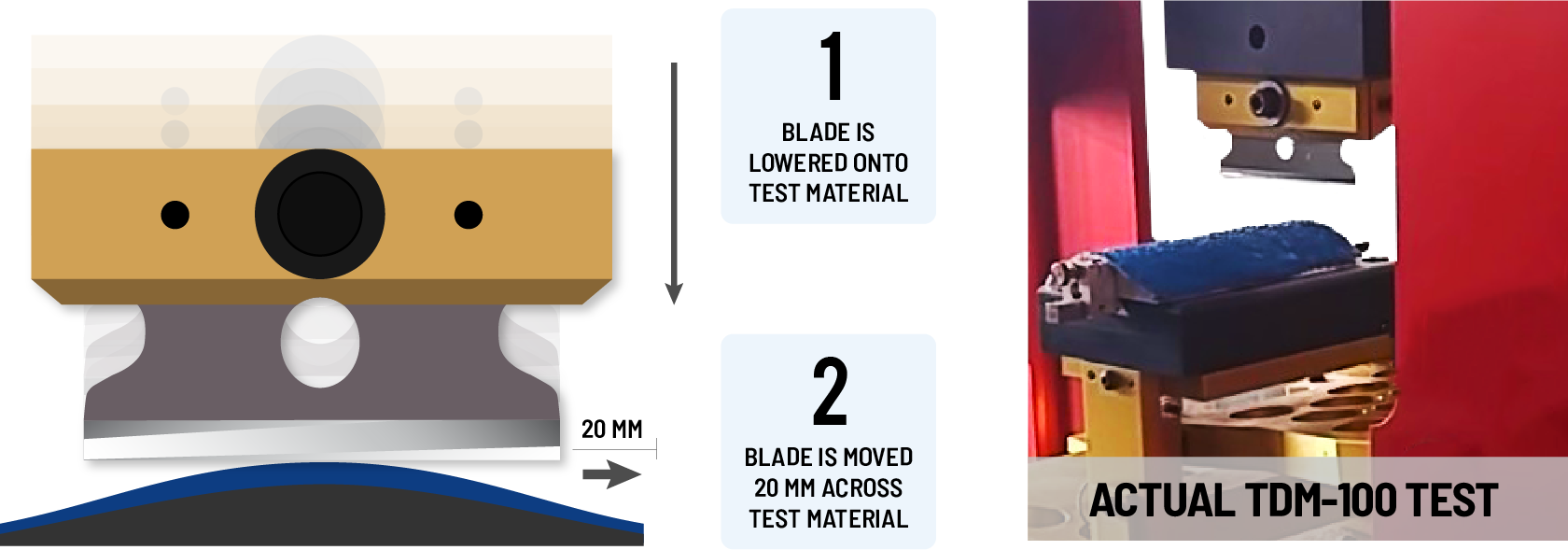
ANSI Puncture Levels
Standards for Puncture Testing
The ANSI/ISEA 105 Puncture Testing tests the performance of hand and arm protection against punctures from pointed objects. It measures how quickly a hole is formed in the glove when a pointed objects attempts to puncture the surface. Results are classified into levels 1-5. Both ANSI/ISEA and EN standards for puncture resistance use the same test, but they use different weights to determine puncture level. In this test a steel stylus punctures a test specimen held on a retaining device. The stylus has a tip of 1 mm and resembles a nail or pencil. The force on the stylus at the moment of puncture is what determines the puncture level.
Puncture Levels

| Puncture Level | Application Examples |
| Level 1 | General Maintenance, General Purpose, Manufacturing, Small Parts Handling |
| Level 2 | Automotive, Construction, General Maintenance, General Purpose, Landscaping, Manufacturing, Material Handling, Small Parts Handling, Warehousing |
| Level 3 | Landscaping, Brickwork, Construction, Assembly, Warehouse, Oil and Gas, Construction, Mining, Petrochemical, Utilities |
| Level 4 | Aerospace Industry, Assembly, Automotive, Carpentry, Construction, Demolition, General Maintenance, Glass Handling, Handling Oily Components, HVAC, Infrastructure Maintenance, Machine Operation, Maintenance, Manufacturing, Material Handling, Metal Fabrication, Parts Handling, Recycling, Roofing, Small Parts Assembly, Steel Framing, Utilities |
| Level 5 | Recycling, Cable, Construction, Demolition, Forestry, Lumber, Rebar Handling, Barbed Wire, Waste Management |
Puncture Testing Process
1. A pointed stylus similar to a ballpoint pen is fitted into the machine at a 90-degree angle.
2. The material to be tested is positioned and secured between two metal plates.
3. The stylus is lowered, penetrating the test fabric at a speed of 100mm/min.
4. Results are reported in Newtons.
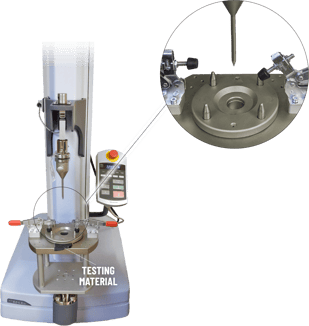
ANSI Abrasion Levels
Standards for Abrasion Testing
The ANSI/ISEA 105 Abrasion Testing identifies the performance characteristics of hand and arm protection products against abrasive contact. This test measures how quickly a hole is formed in the glove after repetitive contact with abrasive material and results are classified on levels 1-6. It also provides a way of measuring how long a glove will last before it wears out. So, for example, an ANSI/ISEA Abrasion Level 6 glove would potentially last twice as long as an ANSI/ISEA 105 Abrasion Level 5 glove.
Abrasion Levels
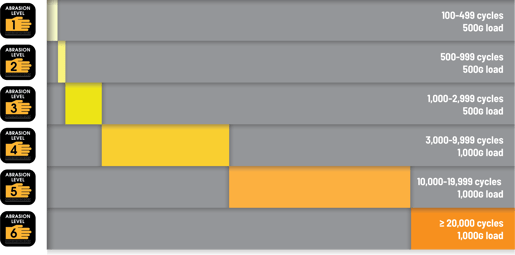
| Abrasion Level | Application Examples |
| Level 1 | Inspection, Painting, Food Processing |
| Level 2 | Electronic Assembly, Pharmaceutical Use |
| Level 3 | General Assembly, Small Parts Assembly, Automotive |
| Level 4 | Metal Fabrication, Carpentry, Construction |
| Level 5 | Landscaping, Brick, Stone Work, Warehouse, Mechanics |
| Level 6 | Oil and Gas, Heavy Equipment, Mining |
Abrasion Testing Process
1. Material to be tested is placed on the rotating base.
2. Abrasive wheels are lowered to contact testing material.
3. Rotating base turns and a counter tracks how many times the base turns before contact is made through the material. Coated fabrics are measured when the material is worn through, uncoated fabrics are measured when the fabric's first thread/yarn is broken.
4. The test is performed with a silver 500- or 1000-gram weight load for levels 1-3 or levels 4-6, respectively.
5. A minimum of 5 specimens are tested using a Taber abrasive wheel to determine the abrasion level.
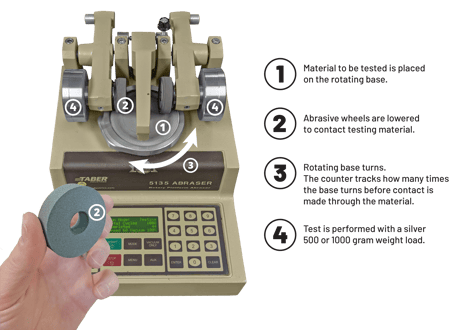
Information provided by Global Glove.